Single-Shot Direct Transmission Terahertz Imaging Based on Intense Broadband Terahertz Radiation
Abstract
:1. Introduction
2. Experimental Setup and Imaging Results
3. Image Processing
4. Discussion
5. Conclusions
Author Contributions
Funding
Institutional Review Board Statement
Informed Consent Statement
Data Availability Statement
Conflicts of Interest
Abbreviations
| THz | terahertz |
| fps | frames per second |
| DCP | dark channel prior |
| MSR | multi-scale retinex |
| PSNR | peak signal-to-noise ratio |
References
- Siegel, P.H. Terahertz technology. IEEE Trans. Microw. Theory Tech. 2002, 50, 910–928. [Google Scholar] [CrossRef]
- Yakovlev, E.V.; Zaytsev, K.I.; Dolganova, I.N.; Yurchenko, S.O. Non-Destructive Evaluation of Polymer Composite Materials at the Manufacturing Stage Using Terahertz Pulsed Spectroscopy. IEEE Trans. THz Sci. Technol. 2015, 5, 810–816. [Google Scholar] [CrossRef]
- Song, H.-J.; Nagatsuma, T. Present and Future of Terahertz Communications. IEEE Trans. THz Sci. Technol. 2011, 1, 256–263. [Google Scholar] [CrossRef]
- King, M.D.; Buchanan, W.D.; Korter, T.M. Identification and quantification of polymorphism in the pharmaceutical compound diclofenac acid by terahertz spectroscopy and solid-state density functional theory. Anal. Chem. 2011, 83, 3786–3792. [Google Scholar] [CrossRef] [PubMed]
- Hu, B.B.; Nuss, M.C. Imaging with Terahertz Waves. Opt. Lett. 1995, 20, 1716–1718. [Google Scholar] [CrossRef] [PubMed]
- Johnson, J.L.; Dorney, T.D.; Mittleman, D.M. Enhanced depth resolution in terahertz imaging using phase-shift interferometry. Appl. Phys. Lett. 2001, 78, 835–837. [Google Scholar] [CrossRef]
- Hunsche, S.; Koch, M.; Brener, I.; Nuss, M.C. THz near-field imaging. Opt. Commun. 1998, 150, 22–26. [Google Scholar] [CrossRef]
- Kiwa, T.; Tonouchi, M.; Yamashita, M.; Kawase, K. Laser terahertz-emission microscope for inspecting electrical faults in integrated circuits. Opt. Lett. 2003, 28, 2058–2060. [Google Scholar] [CrossRef]
- Schade, U.; Holldack, K.; Kuske, P.; Wüstefeld, G.; Hübers, H.W. THz near-field imaging employing synchrotron radiation. Appl. Phys. Lett. 2004, 84, 1422–1424. [Google Scholar] [CrossRef]
- Yamashita, M.; Kawase, K.; Otani, C.; Kiwa, T.; Tonouchi, M. Imaging of large-scale integrated circuits using laser terahertz emission microscopy. Opt. Express 2005, 13, 115–120. [Google Scholar] [CrossRef]
- Chen, X.; Liu, X.; Guo, X.; Chen, S.; Hu, H.; Nikulina, E.; Ye, X.; Yao, Z.; Bechtel, H.A.; Martin, M.C.; et al. THz Near-Field Imaging of Extreme Subwavelength Metal Structures. ACS Photonics 2020, 7, 687–694. [Google Scholar] [CrossRef]
- Brahm, A.; Wilms, A.; Tymoshchuk, M.; Grossmann, C.; Notni, G.; Tünnermann, A. Optical Effects at projection measurements for Terahertz tomography. Opt. Laser Technol. 2014, 62, 49–57. [Google Scholar] [CrossRef]
- Tripathi, S.R.; Sugiyama, Y.; Murate, K.; Imayama, K.; Kawase, K. Terahertz wave three-dimensional computed tomography based on injection-seeded terahertz wave parametric emitter and detector. Opt. Express 2016, 24, 6433–6440. [Google Scholar] [CrossRef] [PubMed]
- Kitahara, H.; Tani, M.; Hangyo, M. Frequency-domain optical coherence tomography system in the terahertz region. Appl. Phys. B 2020, 126, 22. [Google Scholar] [CrossRef]
- Humphreys, M.; Grant, J.P.; Escorcia-Carranza, I.; Accarino, C.; Kenney, M.; Shah, Y.D.; Rew, K.G.; Cumming, D.R.S. Video-rate terahertz digital holographic imaging system. Opt. Express 2018, 26, 25805–25813. [Google Scholar] [CrossRef] [PubMed]
- Heimbeck, M.S.; Everitt, H.O. Terahertz digital holographic imaging. Adv. Opt. Photonics 2020, 12, 1–59. [Google Scholar] [CrossRef]
- Chan, W.L.; Moravec, M.L.; Baraniuk, R.G.; Mittleman, D.M. Terahertz imaging with compressed sensing and phase retrieval. Opt. Lett. 2008, 33, 974–976. [Google Scholar] [CrossRef] [PubMed]
- Chan, W.L.; Charan, K.; Takhar, D.; Kelly, K.F.; Baraniuk, R.G.; Mittleman, D.M. A single-pixel terahertz imaging system based on compressed sensing. Appl. Phys. Lett. 2008, 93, 121105. [Google Scholar] [CrossRef]
- Stantchev, R.I.; Phillips, D.B.; Hobson, P.; Hornett, S.M.; Padgett, M.J.; Hendry, E. Compressed sensing with near-field THz radiation. Optica 2017, 4, 989–992. [Google Scholar] [CrossRef]
- Liu, S.; Hu, X.; Lin, W.; Lu, Z.; Xi, S.; Gong, L.; Wang, X. Terahertz compressed sensing imaging based on line array detection. Opt. Lasers Eng. 2023, 168, 107685. [Google Scholar] [CrossRef]
- Liu, H.-B.; Zhong, H.; Karpowicz, N.; Chen, Y.; Zhang, X.-C. Terahertz Spectroscopy and Imaging for Defense and Security Applications. Proc. IEEE 2007, 95, 1514–1527. [Google Scholar] [CrossRef]
- Shi, S.; Yuan, S.; Zhou, J.; Jiang, P. Terahertz technology and its applications in head and neck diseases. iScience 2023, 26, 107060. [Google Scholar] [CrossRef]
- Fukasawa, R. Terahertz Imaging: Widespread Industrial Application in Non-destructive Inspection and Chemical Analysis. IEEE Trans. Terahertz Sci. Technol. 2015, 5, 1121–1127. [Google Scholar]
- Afsah-Hejri, L.; Akbari, E.; Toudeshki, A.; Homayouni, T.; Alizadeh, A.; Ehsani, R. Terahertz spectroscopy and imaging: A review on agricultural applications. Comput. Electron. Agric. 2020, 177, 105628. [Google Scholar] [CrossRef]
- Castro-Camus, E.; Koch, M.; Mittleman, D.M. Recent advances in terahertz imaging: 1999 to 2021. Appl. Phys. B 2021, 128, 12. [Google Scholar] [CrossRef]
- Banerjee, D.; von Spiegel, W.; Thomson, M.D.; Schabel, S.; Roskos, H.G. Diagnosing water content in paper by terahertz radiation. Opt. Express 2008, 16, 9060–9066. [Google Scholar] [CrossRef] [PubMed]
- Zhao, H.; Wang, Y.; Chen, L.; Shi, J.; Ma, K.; Tang, L.; Xu, D.; Yao, J.; Feng, H.; Chen, T. High-sensitivity terahertz imaging of traumatic brain injury in a rat model. J. Biomed. Opt. 2018, 23, 1–7. [Google Scholar] [CrossRef]
- Yasui, T.; Sawanaka, K.I.; Ihara, A.; Abraham, E.; Hashimoto, M.; Araki, T. Real-time terahertz color scanner for moving objects. Opt. Express 2008, 16, 1208–1221. [Google Scholar] [CrossRef]
- Qin, H.; Li, X.; Sun, J.; Zhang, Z.; Sun, Y.; Yu, Y.; Li, X.; Luo, M. Detection of incoherent terahertz light using antenna-coupled high-electron-mobility field-effect transistors. Appl. Phys. Lett. 2017, 110, 171109. [Google Scholar] [CrossRef]
- Lee, A.W.M.; Hu, Q. Real-time, continuous-wave terahertz imaging by use of a microbolometer focal-plane array. Opt. Lett. 2005, 30, 2563–2565. [Google Scholar] [CrossRef]
- Lee, A.W.M.; Qin, Q.; Kumar, S.; Williams, B.S.; Hu, Q.; Reno, J.L. Real-time terahertz imaging over a standoff distance (>25 meters). Appl. Phys. Lett. 2006, 89, 141125. [Google Scholar] [CrossRef]
- Dem’yanenko, M.A.; Esaev, D.G.; Knyazev, B.A.; Kulipanov, G.N.; Vinokurov, N.A. Imaging with a 90frames/s microbolometer focal plane array and high-power terahertz free electron laser. Appl. Phys. Lett. 2008, 92, 131116. [Google Scholar] [CrossRef]
- Knyazev, B.A.; Cherkassky, V.S.; Choporova, Y.Y.; Gerasimov, V.V.; Vlasenko, M.G.; Dem’yanenko, M.A.; Esaev, D.G. Real-time imaging using a high-power monochromatic terahertz source: Comparative description of imaging techniques with examples of application. J. Infrared Millim. Terahertz Waves 2011, 32, 1207–1222. [Google Scholar] [CrossRef]
- Yasuda, T.; Kawada, Y.; Toyoda, H.; Takahashi, H. Terahertz movies of internal transmission images. Opt. Express 2007, 15, 15583–15588. [Google Scholar] [CrossRef] [PubMed]
- Han, S.-P.; Kim, N.; Lee, W.-H.; Lee, E.S.; Ko, H.; Lee, I.-M.; Moon, K.; Lee, D.H.; Park, K.H. Real-time imaging of moving living objects using a compact terahertz scanner. Appl. Phys. Express 2016, 9, 022501. [Google Scholar] [CrossRef]
- Yao, J.; Yao, R.; Liu, S.; Li, Q.; Wang, Q.; Zhang, X.-C. 1.63-THz transmission imaging experiment by use of a pyroelectric camera array. In Proceedings of the Photonics and Optoelectronics Meetings, Wuhan, China, 24–27 November 2008. [Google Scholar]
- Yao, R.; Li, Q.; Ding, S.; Wang, Q. Investigation on 2.45-THz array transmission imaging. In Proceedings of the International Symposium on Photoelectronic Detection and Imaging, Beijing, China, 17–19 June 2009. [Google Scholar]
- Werley, C.A.; Wu, Q.A.; Lin, K.H.; Tait, C.R.; Dorn, A.; Nelson, K.A. Comparison of phase-sensitive imaging techniques for studying terahertz waves in structured LiNbO. J. Opt. Soc. Am. B 2010, 27, 2350–2359. [Google Scholar] [CrossRef]
- Dey, I.; Jana, K.; Fedorov, V.Y.; Koulouklidis, A.D.; Mondal, A.; Shaikh, M.; Sarkar, D.; Lad, A.D.; Tzortzakis, S.; Couairon, A.; et al. Highly efficient broadband terahertz generation from ultrashort laser filamentation in liquids. Nat. Commun. 2017, 8, 1184. [Google Scholar] [CrossRef] [PubMed]
- Andresen, B.F.; Oda, N.; Fulop, G.F.; Sano, M.; Sonoda, K.i.; Norton, P.R.; Yoneyama, H.; Kurashina, S.; Miyoshi, M.; Sasaki, T.; et al. Development of Terahertz focal plane arrays and handy camera. In Proceedings of the Infrared Technology and Applications XXXVII, Orlando, FL, USA, 25 April 2011. [Google Scholar]
- Oda, N.; Kurashina, S.; Miyoshi, M.; Doi, K.; Ishi, T.; Sudou, T.; Morimoto, T.; Goto, H.; Sasaki, T. Microbolometer Terahertz Focal Plane Array and Camera with Improved Sensitivity in the Sub-Terahertz Region. J. Infrared Millim. Terahertz Waves 2015, 36, 947–960. [Google Scholar] [CrossRef]
- He, K.; Sun, J.; Tang, X. Single Image Haze Removal Using Dark Channel Prior. IEEE Trans. Pattern Anal. Mach. Intell. 2011, 33, 2341–2353. [Google Scholar] [CrossRef]
- Rahman, Z.U.; Jobson, D.J.; Woodell, G.A. Retinex processing for automatic image enhancement. J. Electron. Imaging 2004, 13, 100–110. [Google Scholar] [CrossRef]
- Jobson, D.J.; Rahman, Z.U.; Woodell, G.A. A multiscale retinex for bridging the gap between color images and the human observation of scenes. IEEE Trans. Image Process. 1997, 6, 965–976. [Google Scholar] [CrossRef] [PubMed]
- Liu, N.; Chen, X. Infrared image detail enhancement approach based on improved joint bilateral filter. Infrared Phys. Techn. 2016, 77, 405–413. [Google Scholar] [CrossRef]
- Li, Z.; Zheng, J.; Zhu, Z.; Yao, W.; Wu, S. Weighted guided image filtering. IEEE Trans. Image Process. 2015, 24, 120–129. [Google Scholar] [CrossRef] [PubMed]
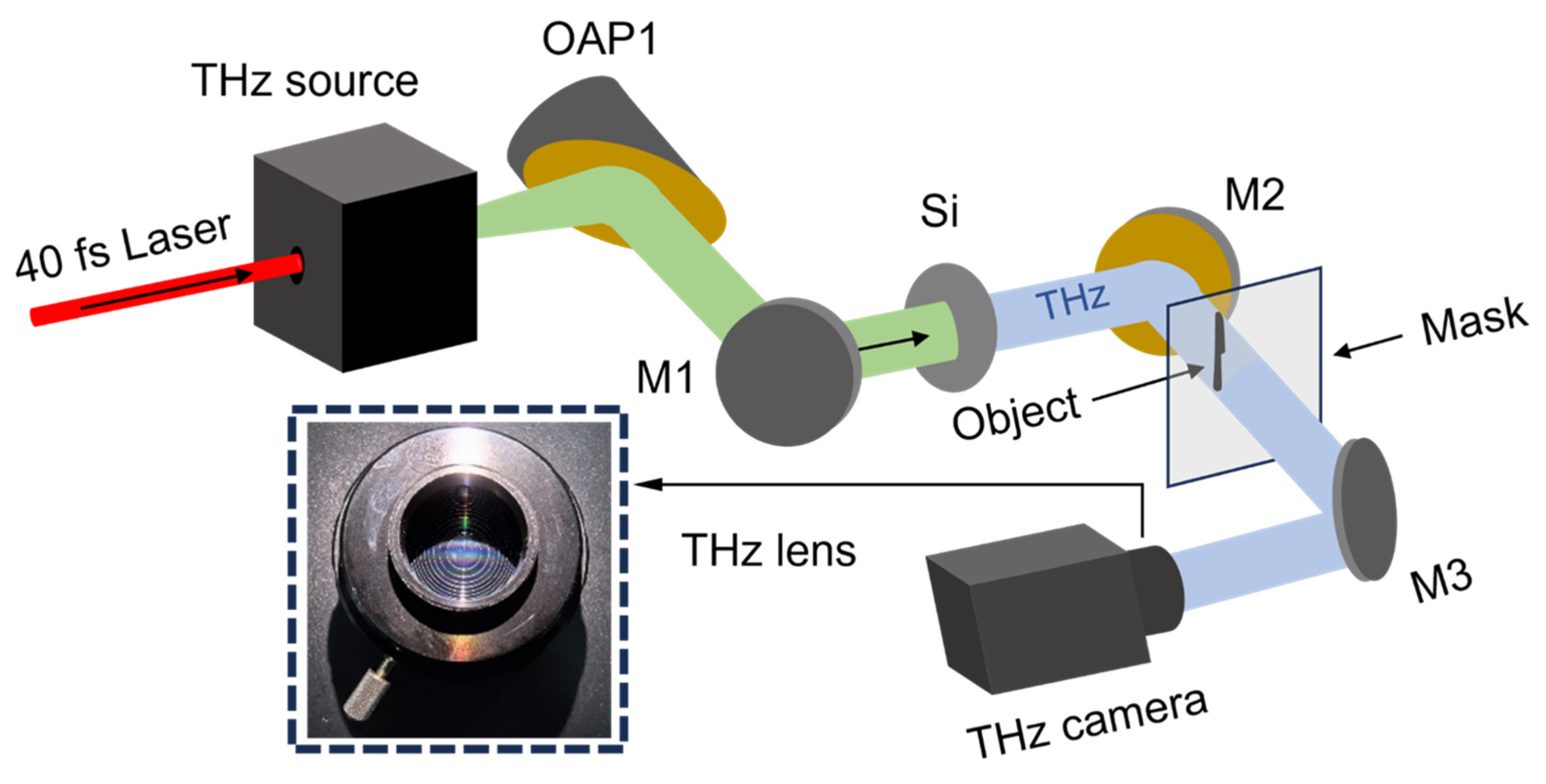
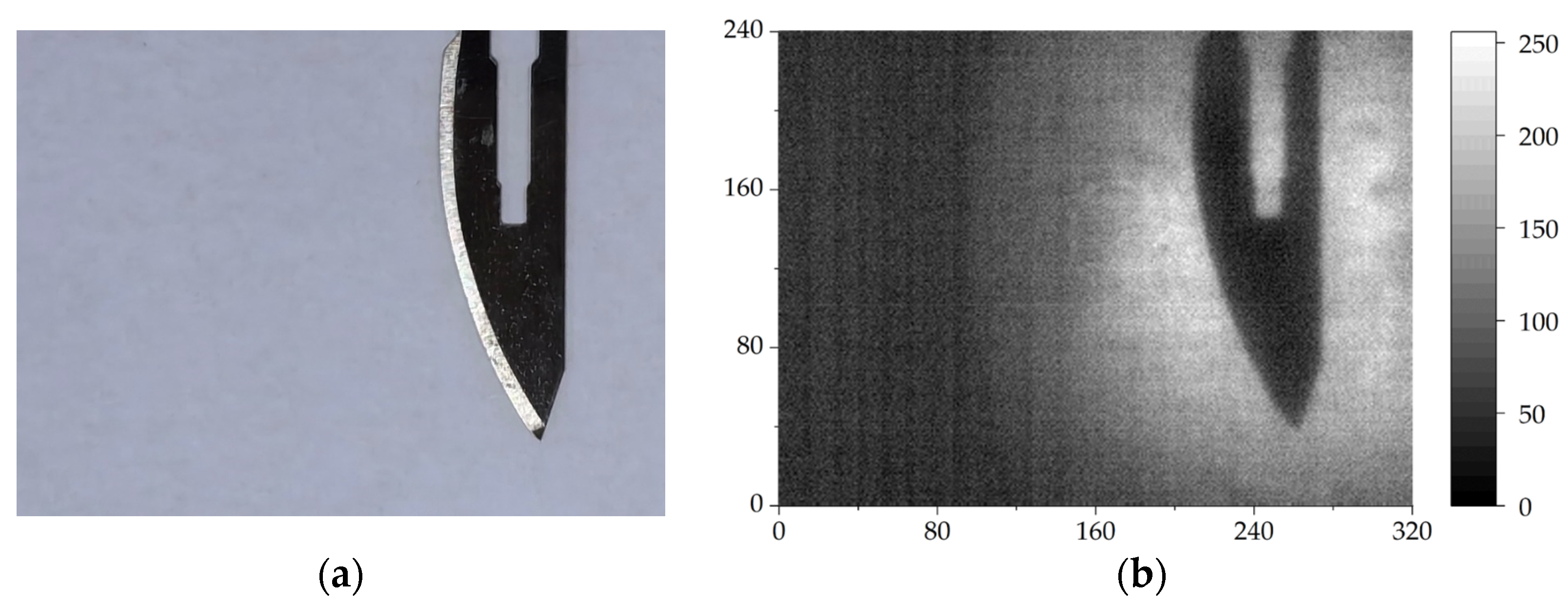
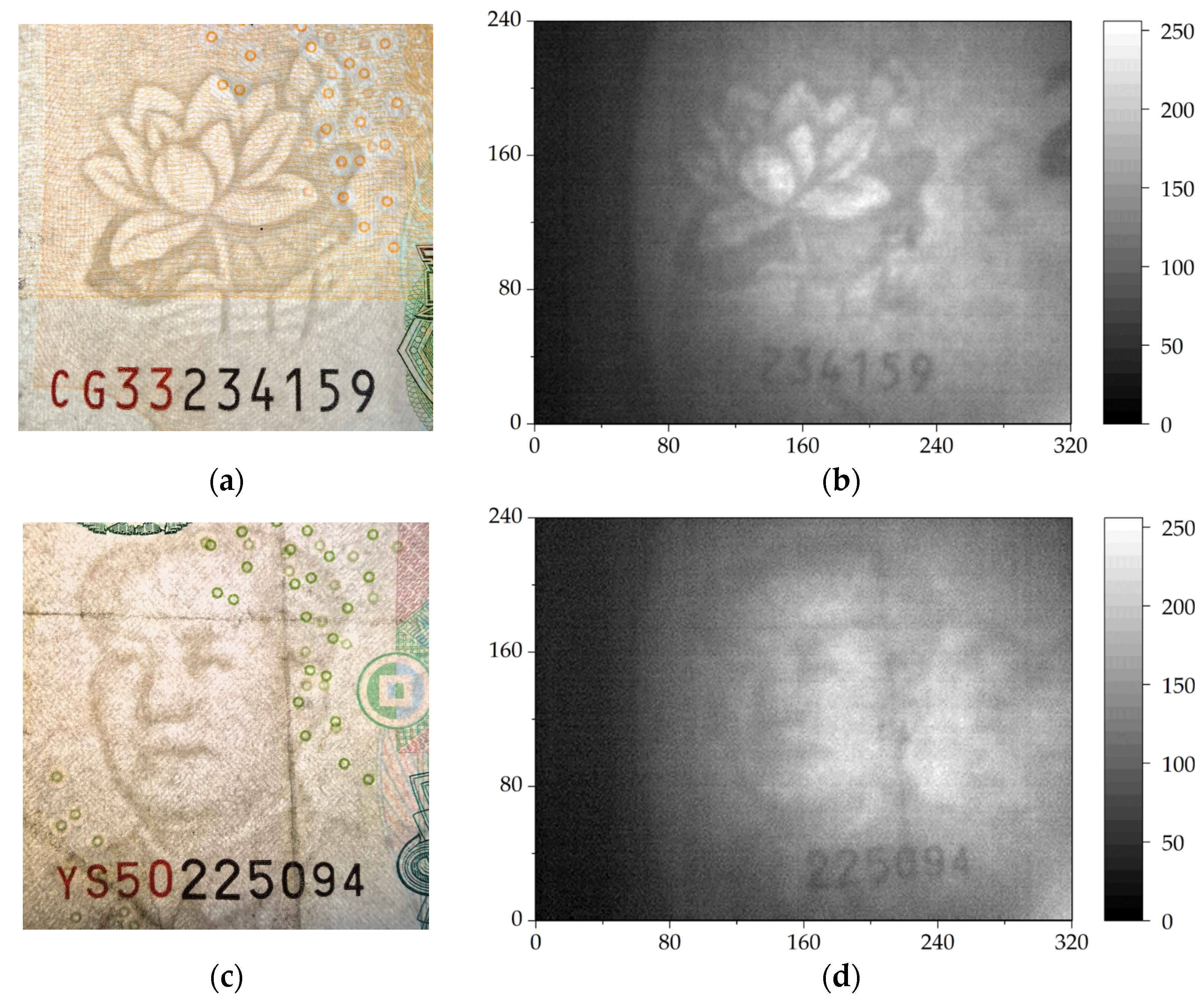
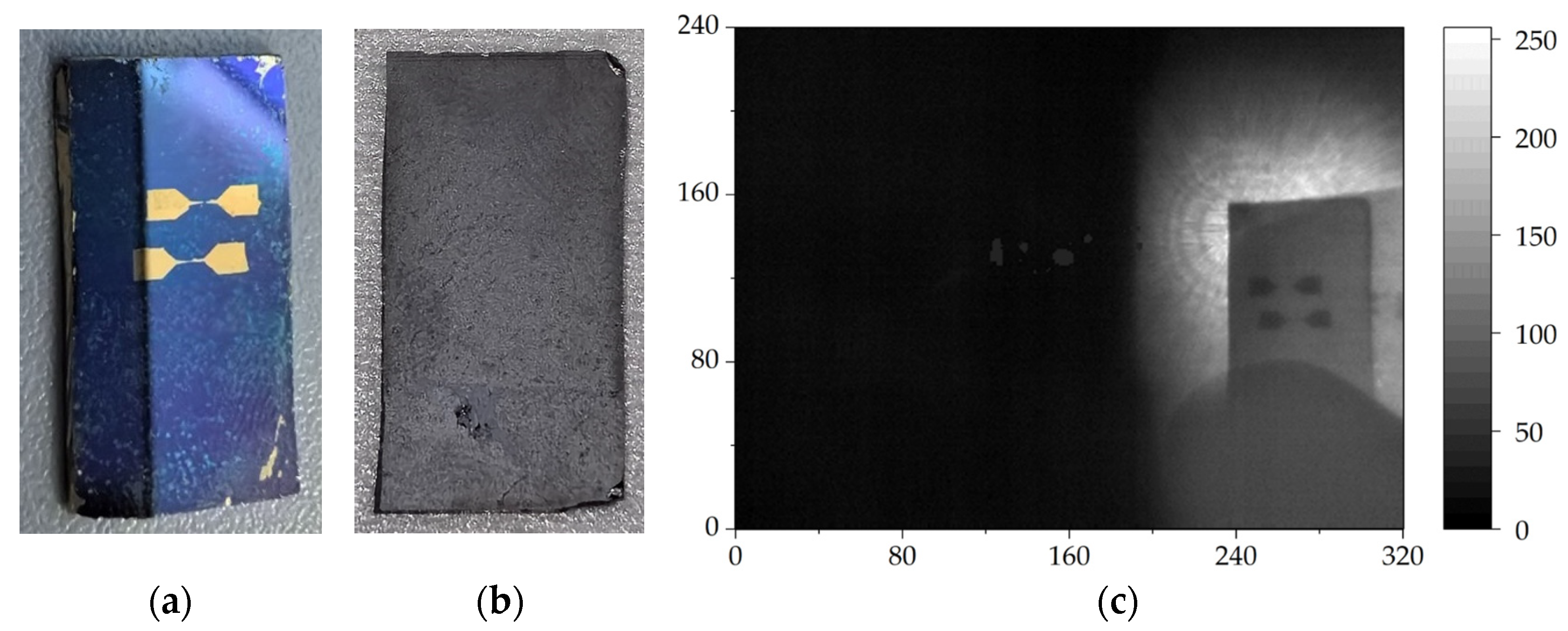
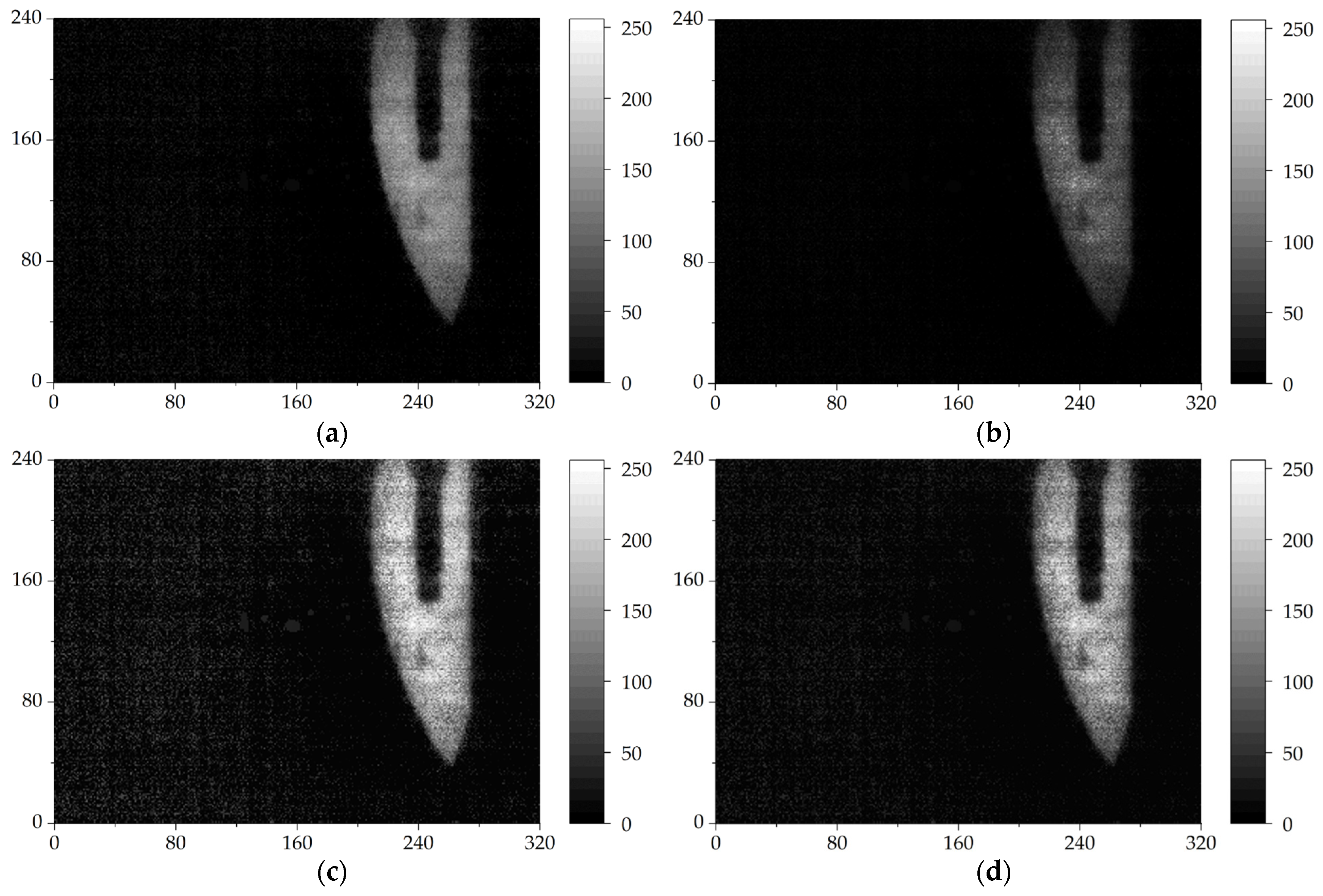
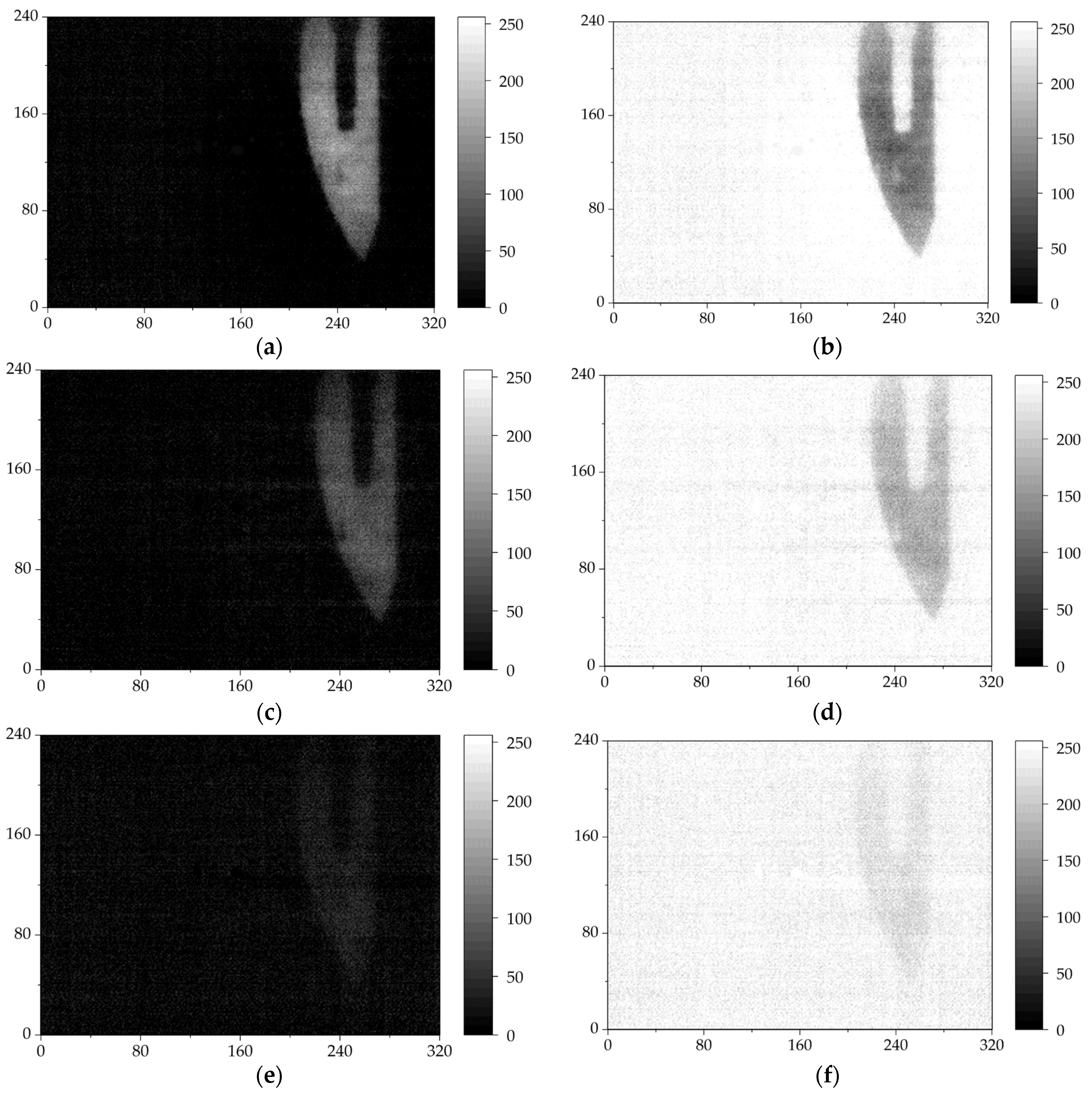
| Algorithm | Brightness | Contrast | Entropy | PSNR |
|---|---|---|---|---|
| Original image | 16.97 | 148.77 | 3.48 | / |
| DCP | 9.06 | 63.01 | 2.95 | 23.50 |
| MSR | 30.28 | 586.94 | 4.02 | 21.61 |
| Improved algorithm | 23.54 | 310.32 | 3.53 | 27.25 |
Disclaimer/Publisher’s Note: The statements, opinions and data contained in all publications are solely those of the individual author(s) and contributor(s) and not of MDPI and/or the editor(s). MDPI and/or the editor(s) disclaim responsibility for any injury to people or property resulting from any ideas, methods, instructions or products referred to in the content. |
© 2024 by the authors. Licensee MDPI, Basel, Switzerland. This article is an open access article distributed under the terms and conditions of the Creative Commons Attribution (CC BY) license (https://creativecommons.org/licenses/by/4.0/).
Share and Cite
Yue, Z.; Peng, X.; Li, G.; Zhou, Y.; Pu, Y.; Zhang, Y. Single-Shot Direct Transmission Terahertz Imaging Based on Intense Broadband Terahertz Radiation. Sensors 2024, 24, 4160. https://doi.org/10.3390/s24134160
Yue Z, Peng X, Li G, Zhou Y, Pu Y, Zhang Y. Single-Shot Direct Transmission Terahertz Imaging Based on Intense Broadband Terahertz Radiation. Sensors. 2024; 24(13):4160. https://doi.org/10.3390/s24134160
Chicago/Turabian StyleYue, Zhang, Xiaoyu Peng, Guangyuan Li, Yilei Zhou, Yezi Pu, and Yuhui Zhang. 2024. "Single-Shot Direct Transmission Terahertz Imaging Based on Intense Broadband Terahertz Radiation" Sensors 24, no. 13: 4160. https://doi.org/10.3390/s24134160
APA StyleYue, Z., Peng, X., Li, G., Zhou, Y., Pu, Y., & Zhang, Y. (2024). Single-Shot Direct Transmission Terahertz Imaging Based on Intense Broadband Terahertz Radiation. Sensors, 24(13), 4160. https://doi.org/10.3390/s24134160






